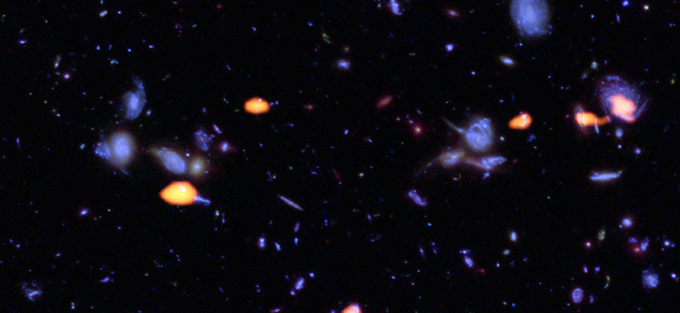ALMA Explores the Hubble Ultra Deep Field: Uncovers Insights into 'Golden Age' of Galaxy Formation
International teams of astronomers, using the Atacama Large Millimeter/submillimeter Array (ALMA), have explored the same distant corner of the Universe first revealed in the iconic image of the Hubble Ultra Deep Field (HUDF).
The new ALMA observations, which are significantly deeper and sharper than previous surveys at millimeter wavelengths, trace the abundance of star-forming gas at different points in time, providing new insights into the "Golden Age" of galaxy formation approximately 10 billion years ago.
The researchers presented their findings today at the Half a Decade of ALMA Conference in Palm Springs, California. The results are also accepted for publication in a series of seven scientific papers appearing in the Astrophysical Journal and one in the Monthly Notices of the Royal Astronomical Society.
Just like the pioneering deep-field observations with the NASA/ESA Hubble Space Telescope, scientists using ALMA surveyed a seemingly unremarkable section of the Cosmos in a so-called “blind search”. This type of observation probes a specific region of space to see what can be discovered serendipitously rather than homing in on a predetermined target, like an individual galaxy or star-forming nebula.
"We conducted the first fully blind, three-dimensional search for cool gas in the early Universe," said Chris Carilli, an astronomer with the National Radio Astronomy Observatory (NRAO) in Socorro, New Mexico, and member of one of the research teams. "Through this, we discovered a population of galaxies that is not clearly evident in any other deep surveys of the sky."
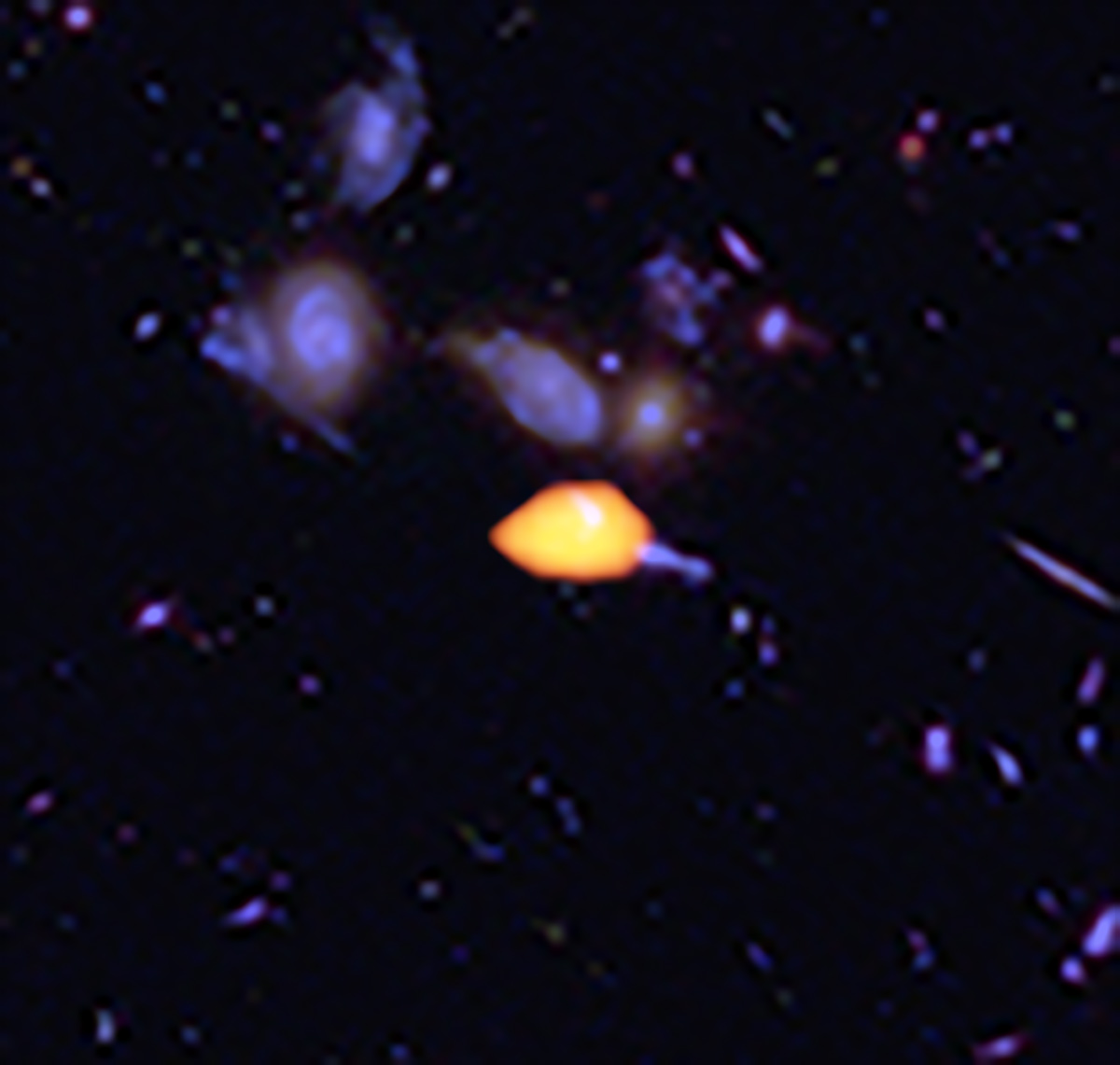
ALMA surveyed the Hubble Ultra Deep Field, uncovering new details of the star-forming history of the Universe. This close-up image reveals one such galaxy (orange), rich in carbon monoxide, showing it is primed for star formation. The blue features are galaxies imaged by Hubble. B. Saxton (NRAO/AUI/NSF); ALMA (ESO/NAOJ/NRAO); NASA/ESA Hubble | Download image
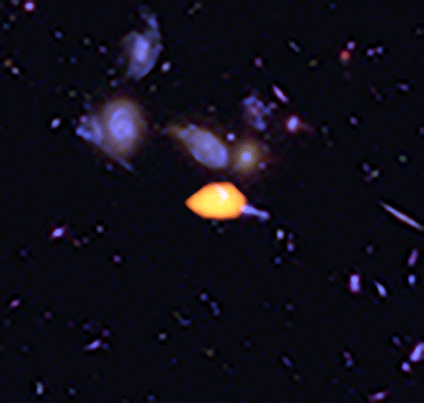
ALMA surveyed the Hubble Ultra Deep Field, uncovering new details of the star-forming history of the Universe. This animated GIF reveals one such galaxy (orange), rich in carbon monoxide, showing it is primed for star formation. The blue features are galaxies imaged by Hubble. Credit: B. Saxton (NRAO/AUI/NSF); ALMA (ESO/NAOJ/NRAO); NASA/ESA Hubble | Download image
Unlike Hubble, which studies visible and infrared light from bright cosmic objects like stars and galaxies, ALMA studies the faint millimeter-wavelength light emitted by cold gas and dust, the raw material of star formation. ALMA's ability to see a completely different portion of the electromagnetic spectrum allows astronomers to study a different class of astronomical objects, such as massive star-forming clouds and protoplanetary disks, as well as objects that are too faint to observe in visible light[1. Earlier searches to map the distribution of cool gas in the early Universe has been carried out using the Plateau de Bure observatory in the French Alps and with the Karl G. Jansky Very Large Array in the US.].
Jim Dunlop, lead author of one of the teams sums up its importance: “This is a breakthrough result. For the first time we are properly connecting the visible and ultraviolet light view of the distant Universe from Hubble and far-infrared/millimeter views of the Universe from ALMA.”
The new ALMA observations were specifically tailored to detect galaxies that are rich in carbon monoxide (CO), a tracer molecule that identifies regions rich in molecular gas and primed for star formation. Even though these molecular gas reservoirs give rise to star formation in galaxies, they are invisible to Hubble. ALMA can therefore reveal the "missing half" of the galaxy formation and evolution process.
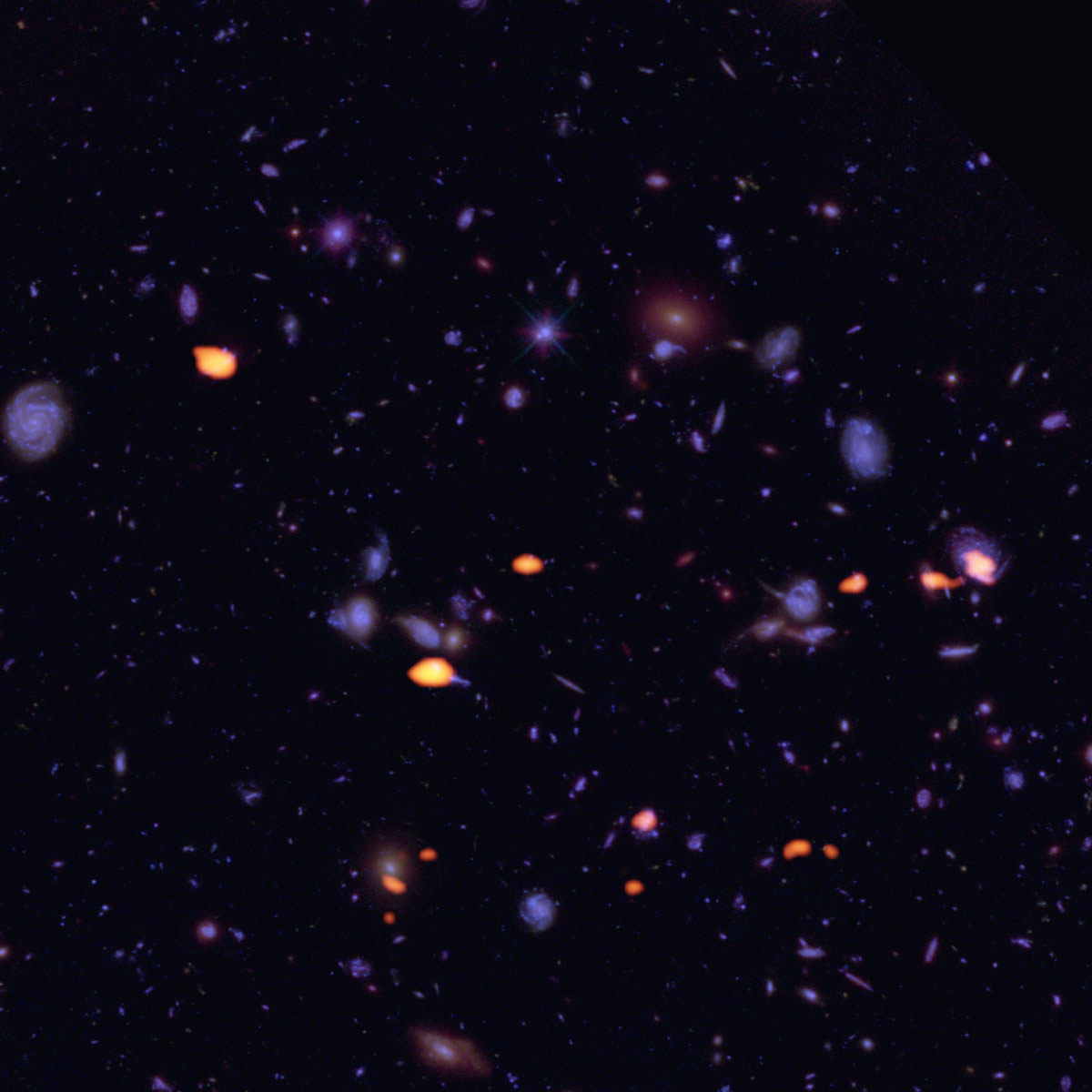
A trove of galaxies, rich in dust and cold (indicating star-forming potential) was imaged by ALMA (orange) in the Hubble Ultra Deep Field. Credit: B. Saxton (NRAO/AUI/NSF); ALMA (ESO/NAOJ/NRAO); NASA/ESA Hubble | Download image
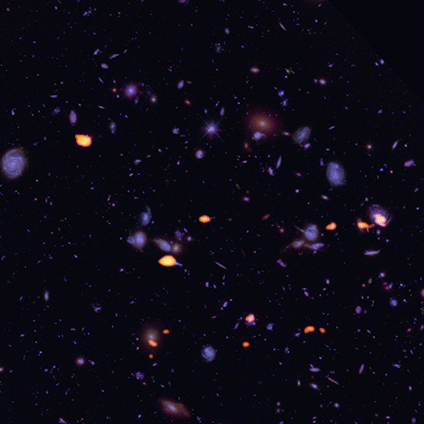
Animated GIF showing a trove of galaxies, rich in dust and cold gas (indicating star-forming potential) that was imaged by ALMA (orange) in the Hubble Ultra Deep Field. Credit: B. Saxton (NRAO/AUI/NSF); ALMA (ESO/NAOJ/NRAO); NASA/ESA Hubble | Download image
"These newly detected carbon-monoxide rich galaxies represent a substantial contribution to the star-formation history of the Universe," said Roberto Decarli, an astronomer with the Max Planck Institute for Astronomy (MPIA) in Heidelberg, Germany, and member of the research team. "With ALMA we have opened a pathway for studying the early formation and assembly of galaxies in the Hubble Ultra Deep Field."
The new ALMA observations of the HUDF include two distinct, yet complementary types of data: continuum observations, which reveal dust emission and star formation, and a spectral line survey, which looks at the cold molecular gas fueling star formation. The line survey is particularly valuable because it includes information about the degree to which light from distant objects has been redshifted by the expansion of the Universe. Greater redshift means that an object is further away and seen farther back in time.
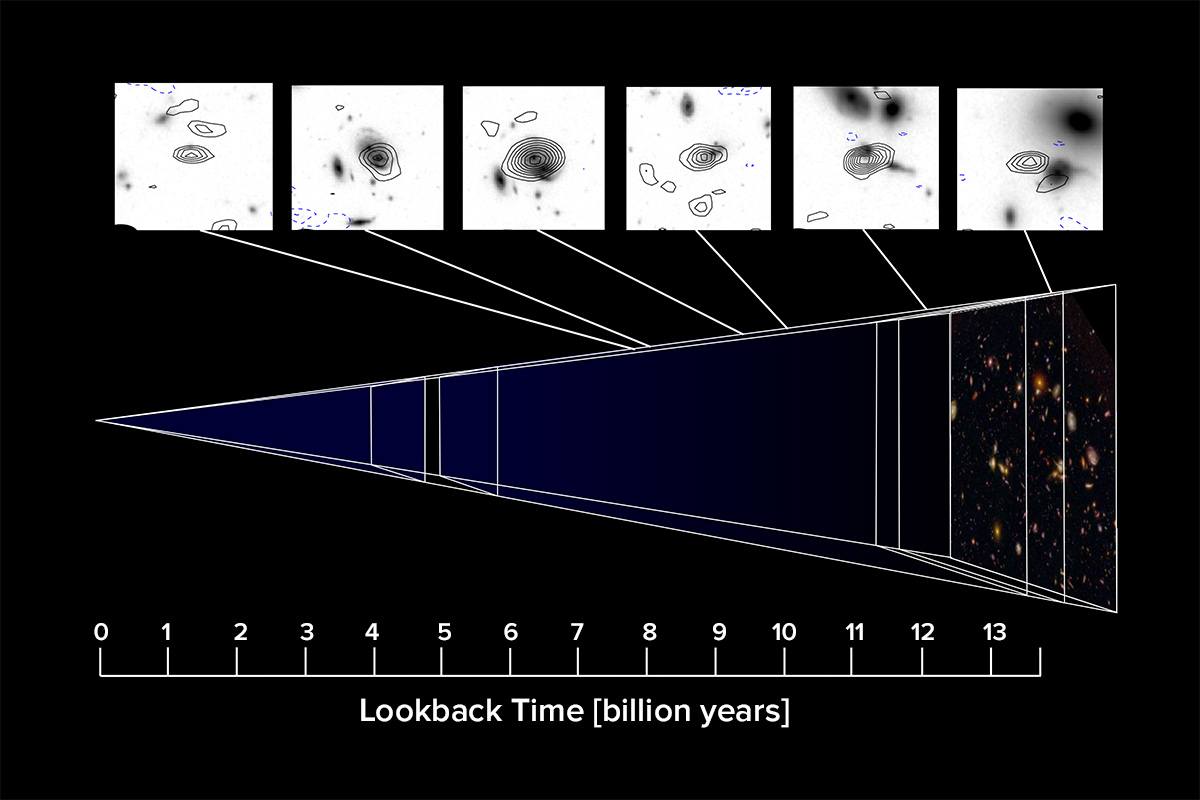
Looking back through cosmic time in the Hubble Ultra Deep Field, ALMA traced the presence of carbon monoxide gas. This enabled astronomers to create a 3-D image of the star-forming potential of the Cosmos. Credit: R. Decarli (MPIA); ALMA (ESO/NAOJ/NRAO) | Download image
With the most recent observations, astronomers were able to create a three-dimensional map of star-forming gas as it evolves over cosmic time, from the present to about two billion years after the Big Bang.
"The new ALMA results confirm a rapidly rising gas content in galaxies with increasing look-back time," said Manuel Aravena, an astronomer with the Diego Portales University in Santiago, Chile, and member of the research team. "This increasing gas content is likely the root cause for the remarkable increase in star formation rates during the peak epoch of galaxy formation, some 10 billion years ago."
Astronomers specifically selected the area of study in the HUDF, a region of space in the constellation Fornax, so ground-based telescopes in the Southern Hemisphere, like ALMA, could probe the region as well, expanding our knowledge of the very distant Universe.
ALMA has observed the HUDF for a total of around 50 hours up to now. This is the largest amount of ALMA observing time spent on one area of the sky so far. An approved future 150-hour observing campaign dubbed ASPECS – the ALMA Spectroscopic Survey in the Hubble UDF -- will deeply cover a much larger area and further illuminate the star-forming potential history of the Universe.
"By supplementing our understanding of this missing star-forming material, the forthcoming large spectroscopic survey will complete our view of the well-known galaxies in the iconic Hubble Ultra Deep Field," said Fabian Walter, also with the MPIA and member of the research team.
Animation revealing ALMA's exploration of the Hubble Ultra Deep Field. The new ALMA observations, which are significantly deeper and sharper than previous surveys at millimeter wavelengths, reveal a population of galaxies that is not clearly evident in any other deep surveys of the sky and trace the previously unknown abundance of star-forming gas at different points in time. Credit: B. Saxton (NRAO/AUI/NSF); ALMA (ESO/NAOJ/NRAO); NASA/ESA Hubble. Music: Mark Mercury
Interview with astronomer Fabian Walter explaining recent ALMA observations of the Hubble Ultra Deep Field. Credit: B. Saxton & J. Hellerman (NRAO/AUI/NSF); ALMA (ESO/NAOJ/NRAO); NASA/ESA Hubble
Adittional information
The ALMA Spectroscopic Survey in the Hubble UDF (ASPECS) is designated a so-called "Large Program" for ALMA and has been approved for observations during Cycle 4, which begins October 2016 and continues through September 2017. The principal investigators on that proposal are Chris Carilli, National Radio Astronomy Observatory; Fabian Walter, Max Planck Institute for Astronomy; and Manuel Aravena, Diego Portales University.
The following papers are accepted for publication in the Astrophysical Journal [https://apj.aas.org].
- "ALMA Spectroscopic Survey in the Hubble Ultra Deep Field: Search for [CII] line and dust emission in 6<z<8 galaxies," M. Aravena et al. [Preprint: https://arxiv.org/abs/1607.06773].
- "ALMA Spectroscopic Survey in the Hubble Ultra Deep Field: implications for spectral line intensity mapping at millimeter wavelengths and CMB spectral distortions," C.L. Carilli et al. [Preprint: https://arxiv.org/abs/1607.06772].
- "ALMA Spectroscopic Survey in the Hubble Ultra Deep Field: Molecular gas reservoirs in high-redshift galaxies," R. Decarli et al. [Preprint: https://arxiv.org/abs/1607.06773].
- "ALMA Spectroscopic Survey in the Hubble Ultra Deep Field: CO luminosity functions and the evolution of the cosmic density of molecular gas," R. Decarli et al. [Preprint: https://arxiv.org/abs/1607.06771].
- "ALMA spectroscopic survey in the Hubble Ultra Deep Field: Continuum number counts, resolved 1.2-mm extragalactic background, and properties of the faintest dusty star forming galaxies," M. Aravena et al. [Preprint: https://arxiv.org/abs/1607.06770].
- "ALMA Spectroscopic Survey in the Hubble Ultra Deep Field: Survey description," F. Walter et al. [Preprint: https://arxiv.org/abs/1607.06769].
- "ALMA Spectroscopic Survey in the Hubble Ultra Deep Field: The Infrared Excess of UV-selected z=2-10 galaxies as a function of UV-continuum Slope and Stellar Mass," R. Bouwens et al. [Preprint: https://arxiv.org/abs/1607.06768].
- "ALMA Spectroscopic Survey in the Hubble Ultra Deep Field: The Infrared Excess of UV-selected z=2-10 galaxies as a function of UV-continuum Slope and Stellar Mass," R. Bouwens et al. [Preprint: https://arxiv.org/abs/1606.00227].
An additional survey of the HUDF, "A deep ALMA image of the Hubble Ultra Deep Field", by J. Dunlop et al., will appear in the Monthly Notices of the Royal Astronomical Society. [Preprint: https://arxiv.org/abs/1606.00227
The teams are composed of:
M. Aravena (Núcleo de Astronomía, Universidad Diego Portales, Santiago, Chile), R. Decarli (Max-Planck Institut für Astronomie, Heidelberg, Germany), F. Walter (Max-Planck Institut für Astronomie, Heidelberg, Germany; Astronomy Department, California Institute of Technology, USA; NRAO, Pete V. Domenici Array Science Center, USA), R. Bouwens (Leiden Observatory, Leiden, The Netherlands; UCO/Lick Observatory, Santa Cruz, USA), P.A. Oesch (Astronomy Department, Yale University, New Haven, USA), C.L. Carilli (Leiden Observatory, Leiden, The Netherlands; Astrophysics Group, Cavendish Laboratory, Cambridge, UK), F.E. Bauer (Instituto de Astrofísica, Pontificia Universidad Católica de Chile, Santiago, Chile; Millennium Institute of Astrophysics, Chile; Space Science Institute, Boulder, USA), E. Da Cunha (Research School of Astronomy and Astrophysics, Australian National University, Canberra, Australia; Center for Astrophysics and Supercomputing, Swinburne University of Technology, Hawthorn, Australia), E. Daddi (Laboratoire AIM, CEA/DSM-CNRS-Université Paris Diderot, Orme des Merisiers, France), J. Gónzalez-López (Instituto de Astrofísica, Pontificia Universidad Católica de Chile, Santiago, Chile), R.J. Ivison (European Southern Observatory, Garching bei München, Germany; Institute for Astronomy, University of Edinburgh, Edinburgh, UK), D.A. Riechers (Cornell University, 220 Space Sciences Building, Ithaca, USA), I. Smail (Institute for Computational Cosmology, Durham University, Durham, UK), A.M. Swinbank (Institute for Computational Cosmology, Durham University, Durham, UK), A. Weiss (Max-Planck-Institut für Radioastronomie, Bonn, Germany), T. Anguita (Departamento de Ciencias Físicas, Universidad Andrés Bello, Santiago, Chile; Millennium Institute of Astrophysics, Chile), R. Bacon (Université Lyon 1, Saint Genis Laval, France), E. Bell (Department of Astronomy, University of Michigan, USA), F. Bertoldi (Argelander Institute for Astronomy, University of Bonn, Bonn, Germany), P. Cortes (Joint ALMA Observatory - ESO, Santiago, Chile; NRAO, Pete V. Domenici Array Science Center, USA), P. Cox (Joint ALMA Observatory - ESO, Santiago, Chile), J. Hodge (Leiden Observatory, Leiden, The Netherlands), E. Ibar (Instituto de Física y Astronomía, Universidad de Valparaíso, Valparaiso, Chile), H. Inami (Université Lyon 1, Saint Genis Laval, France), L. Infante (Instituto de Astrofísica, Pontificia Universidad Católica de Chile, Santiago, Chile), A. Karim (Argelander Institute for Astronomy, University of Bonn, Bonn, Germany), B. Magnelli (Argelander Institute for Astronomy, University of Bonn, Bonn, Germany), K. Ota (Kavli Institute for Cosmology, University of Cambridge, Cambridge, UK; Cavendish Laboratory, University of Cambridge, UK), G. Popping (European Southern Observatory, Garching bei München, Germany), P. van der Werf (Leiden Observatory, Leiden, The Netherlands), J. Wagg (SKA Organization, Cheshire, UK), Y. Fudamoto (European Southern Observatory, Garching bei München, Germany; Universität-Sternwarte München, München, Germany), D. Elbaz (Laboratoire AIM, CEA/DSM-CNRS-Universite Paris Diderot, France), S. Chapman (Dalhousie University, Halifax, Nova Scotia, Canada), L.Colina (ASTRO-UAM, UAM, Unidad Asociada CSIC, Spain), H.W. Rix (Max-Planck Institut für Astronomie, Heidelberg, Germany), Mark Sargent (Astronomy Center, University of Sussex, Brighton, UK), Arjen van der Wel (Max-Planck Institut für Astronomie, Heidelberg, Germany)
K. Sheth (NASA Headquarters, Washington DC, USA), Roberto Neri (IRAM, Saint-Martin d’Hères, France), O. Le Fèvre (Aix Marseille Université, Laboratoire d’Astrophysique de Marseille, Marseille, France), M. Dickinson (Steward Observatory, University of Arizona, USA), R. Assef (Núcleo de Astronomía, Universidad Diego Portales, Santiago, Chile), I. Labbé (Leiden Observatory, Leiden University, Netherlands), S. Wilkins (Astronomy Center, University of Sussex, Brighton, UK), J.S. Dunlop (University of Edinburgh, Royal Observatory, Edinburgh, United Kingdom), R.J. McLure (University of Edinburgh, Royal Observatory, Edinburgh, United Kingdom), A.D. Biggs (ESO, Garching, Germany), J.E. Geach (University of Hertfordshire, Hatfield, United Kingdom), M.J. Michałowski (University of Edinburgh, Royal Observatory, Edinburgh, United Kingdom), W. Rujopakarn (Chulalongkorn University, Bangkok, Thailand), E. van Kampen (ESO, Garching, Germany), A. Kirkpatrick (University of Massachusetts, Amherst, Massachusetts, USA), A. Pope (University of Massachusetts, Amherst, Massachusetts, USA), D. Scott (University of British Columbia, Vancouver, British Columbia, Canada), T.A. Targett (Sonoma State University, Rohnert Park, California, USA), I. Aretxaga (Instituto Nacional de Astrofísica, Optica y Electronica, Mexico), J.E. Austermann (NIST Quantum Devices Group, Boulder, Colorado, USA), P.N. Best (University of Edinburgh, Royal Observatory, Edinburgh, United Kingdom), V.A. Bruce (University of Edinburgh, Royal Observatory, Edinburgh, United Kingdom), E.L. Chapin (Herzberg Astronomy and Astrophysics, National Research Council Canada, Victoria, Canada), S. Charlot (Sorbonne Universités, UPMC-CNRS, UMR7095, Institut d’Astrophysique de Paris, Paris, France), M. Cirasuolo (ESO, Garching, Germany), K.E.K. Coppin (University of Hertfordshire, College Lane, Hatfield, United Kingdom), R.S. Ellis (ESO, Garching, Germany), S.L. Finkelstein (The University of Texas at Austin, Austin, Texas, USA), C.C. Hayward (California Institute of Technology, Pasadena, California, USA), D.H. Hughes (Instituto Nacional de Astrofísica, Optica y Electronica, Mexico), S. Khochfar (University of Edinburgh, Royal Observatory, Edinburgh, United Kingdom), M.P. Koprowski (University of Hertfordshire, College Lane, Hatfield, United Kingdom), D. Narayanan (Haverford College, Haverford, Pennsylvania, USA), C. Papovich (Texas A & M University, College Station, Texas, USA), J.A. Peacock (University of Edinburgh, Royal Observatory, Edinburgh, United Kingdom), B. Robertson (University of California, Santa Cruz, Santa Cruz, California, USA), T. Vernstrom (Dunlap Institute for Astronomy and Astrophysics, University of Toronto, Toronto, Ontario, Canada), G.W. Wilson (University of Massachusetts, Amherst, Massachusetts, USA) and M. Yun (University of Massachusetts, Amherst, Massachusetts, USA).
The Atacama Large Millimeter/submillimeter Array (ALMA), an international astronomy facility, is a partnership of the European Organisation for Astronomical Research in the Southern Hemisphere (ESO), the U.S. National Science Foundation (NSF) and the National Institutes of Natural Sciences (NINS) of Japan in cooperation with the Republic of Chile. ALMA is funded by ESO on behalf of its Member States, by NSF in cooperation with the National Research Council of Canada (NRC) and the Ministry of Science and Technology (MOST) in Taiwan and by NINS in cooperation with the Academia Sinica (AS) in Taiwan and the Korea Astronomy and Space Science Institute (KASI).
ALMA construction and operations are led by ESO on behalf of its Member States; by the National Radio Astronomy Observatory (NRAO), managed by Associated Universities, Inc. (AUI), on behalf of North America; and by the National Astronomical Observatory of Japan (NAOJ) on behalf of East Asia. The Joint ALMA Observatory (JAO) provides the unified leadership and management of the construction, commissioning and operation of ALMA.
Contacts
-
Nicolás Lira
Education and Public Outreach CoordinatorJoint ALMA Observatory, Santiago - ChilePhone: +56 2 2467 6519Cel: +56 9 9445 7726Email: [email protected] -
Charles E. Blue
Public Information OfficerNational Radio Astronomy Observatory Charlottesville, Virginia - USAPhone: +1 434 296 0314Cel: +1 202 236 6324Email: [email protected] -
Richard Hook
Public Information Officer, ESOGarching bei München, GermanyPhone: +49 89 3200 6655Cel: +49 151 1537 3591Email: [email protected] -
Masaaki Hiramatsu
Education and Public Outreach Officer, NAOJ Chile
